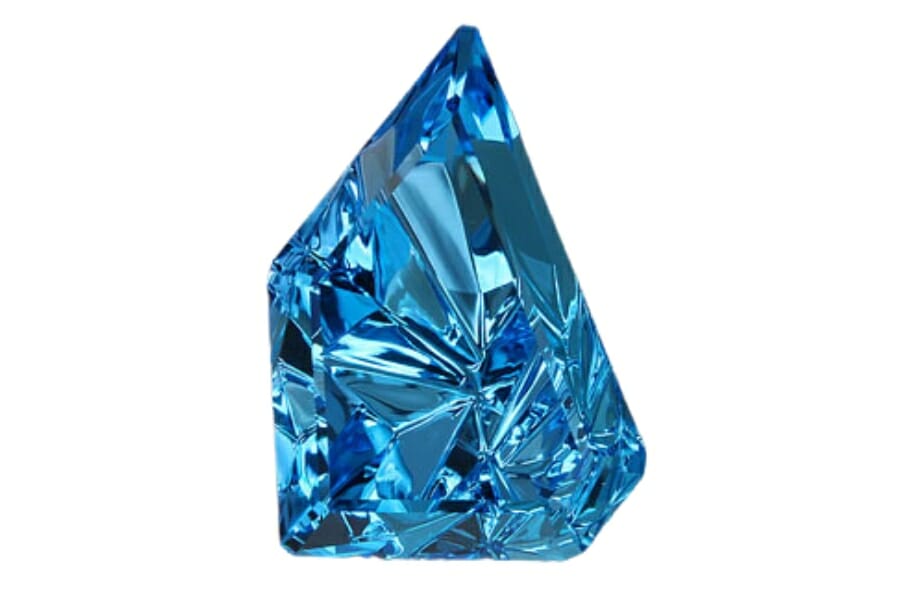Texas, the land of big skies and even bigger hearts has a secret that will blow your mind: the massive variety of rocks, minerals, and gems you can find there. Geology enthusiasts will love this place!
From the rugged canyons of Palo Duro to the rolling hill of the Hill Country, the Lone State flaunts a mesmerizing assortment of geological wonders that will make your jaw drop. You’ll be blown away by the beautiful rock formations and the mysterious volcanic formations that pop up here and there.
Delicate blue topaz, fiery opals, and star agate are some of the state’s gemological treasures. With such a dazzling array of colors and patterns, it’s no wonder why folks come from all around to explore Texas’ riches and geological phenomena.
No matter how much experience you have with rocks, there is something here for everyone to admire and enjoy. Let’s embrace the beauty and variety of the stones in the state and let your curiosity lead the way!
A List of The Common Rocks, Stones, and Minerals Found in Texas
Let’s begin by discussing some of the state’s most common rocks and minerals. Check out the following articles, where we go into much detail.
The Texas State Rock, Mineral, and Gem
Before we get into the details, it’s good to know what the official natural treasures of the state are:
| Texas State Rock | Petrified Palm Wood |
| Texaxs State Mineral | Silver |
| Texas State Gem | Blue Topaz |
You can learn more about the state’s geology policy by visiting the Texas Parks and Wildlife Department website.
Always Confirm Access and Collection Rules!
Before heading out to any of the locations on our list you need to confirm access requirements and collection rules for both public and private locations directly with the location. We haven’t personally verified every location and the access requirements and collection rules often change without notice.
Many of the locations we mention will not allow collecting but are still great places for those who love to find beautiful rocks and minerals in the wild without keeping them. We also can’t guarantee you will find anything in these locations since they are constantly changing.
Always get updated information directly from the source ahead of time to ensure responsible rockhounding. If you want even more current options it’s always a good idea to contact local rock and mineral clubs and groups
Alabaster
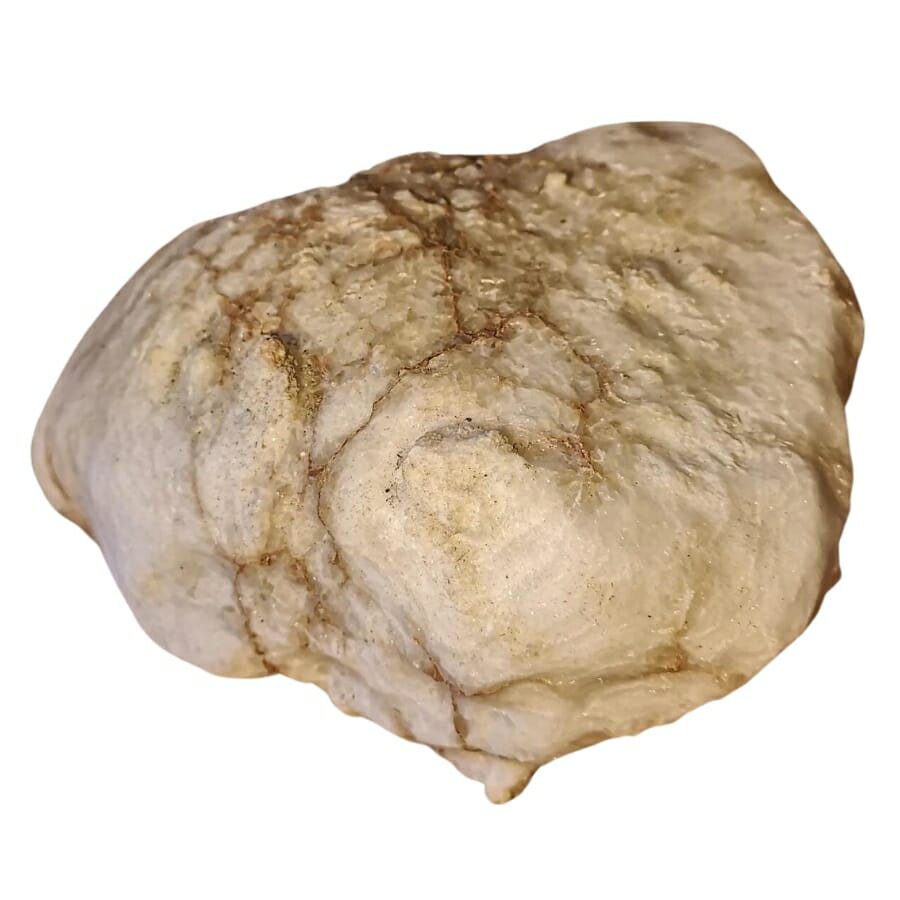
Alabaster is a beautiful mineral attracting artists and collectors for hundreds of years. It’s a soft, clear form of the mineral gypsum made of calcium sulfate. Alabaster deposits form when water dissolves calcium sulfate and then evaporates.
The result is a stunning stone that looks delicate and ethereal and seems to glow from the inside. It’s precious for both its beauty and its usefulness. Its softness and delicate appearance make it a preferred material for sculptors who can craft intricate masterpieces.
It’s also highly valued for its use in making beautiful lamps, bowls, and other home decor items. When lit from behind, the stone has a glowing quality that makes any room feel peaceful and calm. It’s incredible how many things you can do with alabaster.
Where you can find Alabaster in Texas
You can find Alabaster easily in Texas, especially in these locations:
- Area around Palo Duro Canyon
- Red River
Epidote
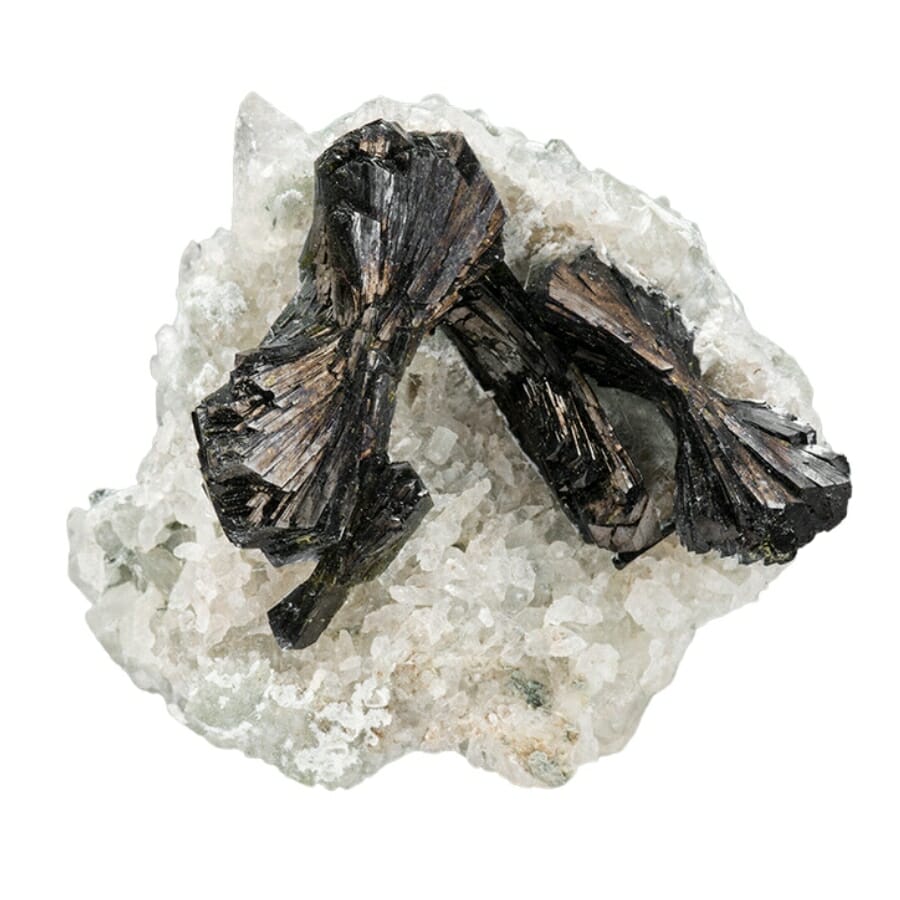
Epidote is a mineral with a story to tell. It’s a calcium aluminum iron silicate known for its mesmerizing crystal structure and bright green color. Its fascinating beauty comes from its complex, prismatic crystals, which can form in several striking ways.
The crystalline structures of this mineral are a wonder of nature. They range from needle-like clusters to unique hexagonal prisms.
The story of how epidote came to be is a tale of metamorphism and transformation. As igneous and sedimentary rocks undergo intense heat and pressure deep within the Earth’s crust, minerals react and rearrange.
This mineral is commonly found in metamorphic rocks like schist and gneiss, as well as in hydrothermal veins and as a product of contact metamorphism. Its presence is a testament to the geological processes that have shaped our planet.
It’s more than just a pretty face because this mineral can be used for many things, making it valuable beyond its beauty. Its bright green color and strong durability make it a good choice for lapidaries, who cut and polish it to make gemstones for jewelry and other decorative pieces.
Where you can find Epidote in Texas
There are many places in the state where epidote can be found, such as:
- West to Enchanted Rock in Llano County
- Charles Moss Ranch in Llano County
Feldspar
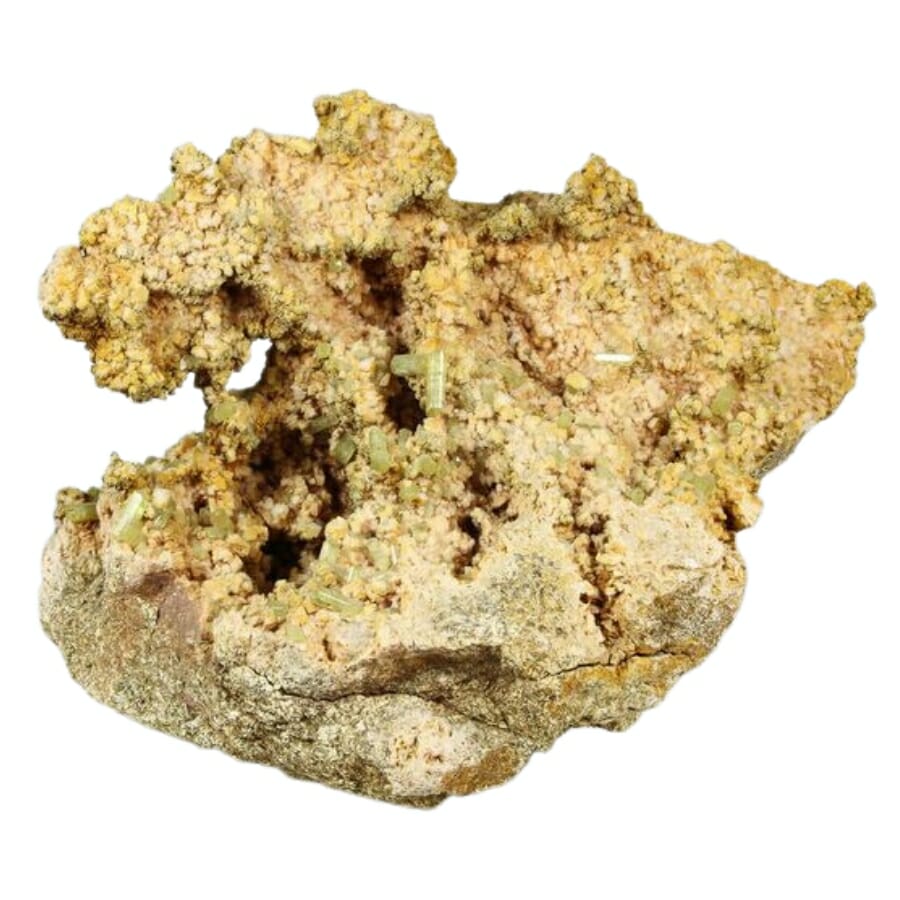
Feldspar is a mineral that has been around since the beginning of time. It plays a key role in shaping the Earth’s crust and is used in many industries. It’s a group of tectosilicate minerals found in rocks that make up about 60% of the Earth’s crust.
It usually forms when molten magma cools and hardens in igneous rocks or as part of metamorphic rocks that have changed because of heat and pressure. Over time, weathering and erosion break down these rocks, releasing feldspar minerals into sediments, soils, and water bodies.
It has many uses because it has many properties and is easy to find. Feldspar is used as a flux in the ceramics and glass industries to lower the melting point of materials and make them stronger.
It’s one of the most important parts of making glass, porcelain, and enamel. It’s also a good source of alumina and alkali metal oxides, which are essential for many industrial products like paints, abrasives, and electrical insulators.
Feldspar’s economic and industrial significance and crucial role in geology solidify its position as a cherished mineral worldwide.
Where you can find Feldspar in Texas
You can find feldspar in Texas, specifically at the ranches of Mason County.
Gypsum
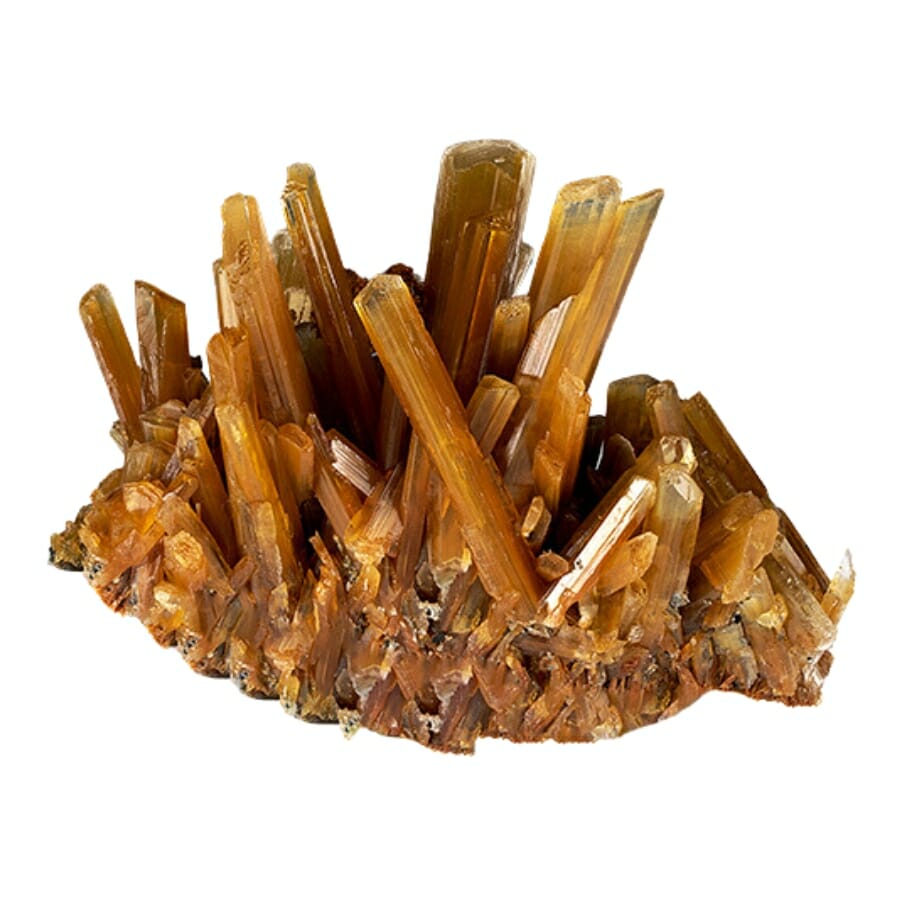
Gypsum is like the chameleon of the mineral world because it can change into many different forms. It’s made of calcium sulfate dihydrate and is a soft sulfate mineral. But here’s the fun part: it can come in many different shapes, from tiny crystals that look like snow to strange rock formations.
You can find it in colors like white, pink, and even brown that look great. It’s born when ancient oceans and salty lakes evaporate, leaving behind a trail of minerals. As the water slowly disappears, they crystallize and form those jaw-dropping structures we know and love.
Gypsum is full of tricks and is always ready to put on a show. You can find it in plaster and drywall, giving your homes a cozy touch. It’s also a natural superstar in agriculture because it improves the structure of the soil and helps plants grow happily and healthily.
Where you can find Gypsum in Texas
Gypsum is common in the state, especially in these places:
- Palo Duro Canyon State Park
- In between Red River and US-62
Microcline
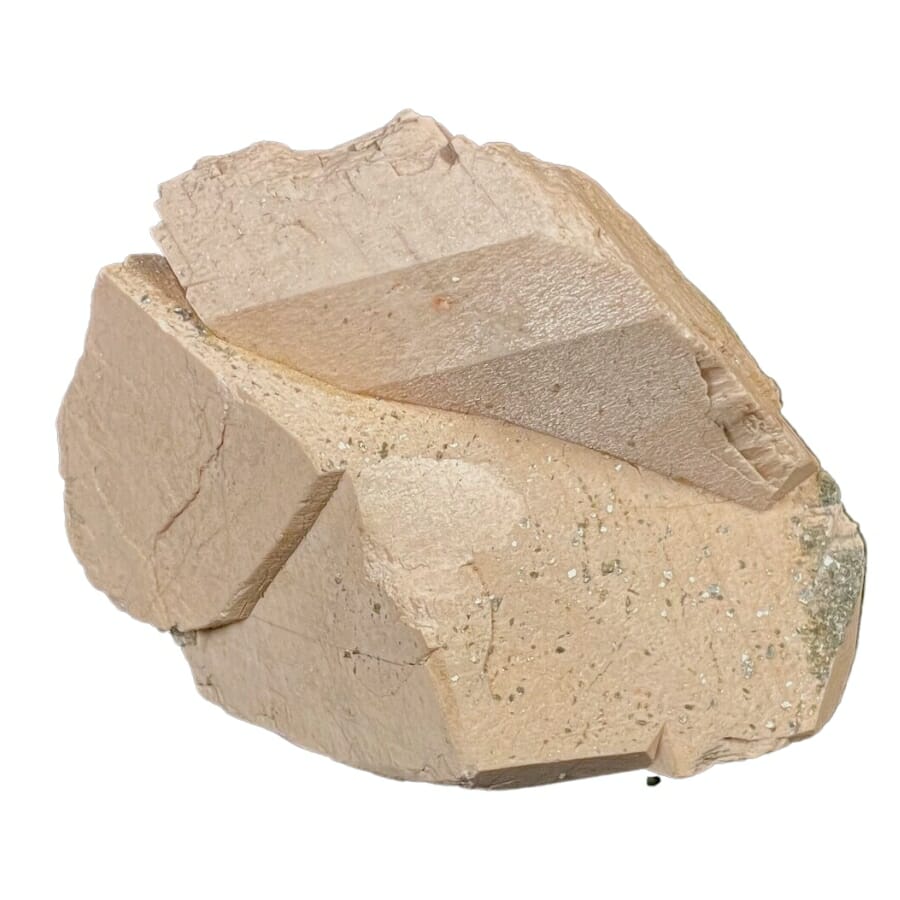
Microcline is known for having colors like pink, green, and sometimes even blue. What makes it truly special is its distinct cross-hatch twinning patterns, setting it apart from its feldspar cousins.
This gorgeous mineral is made when hot, molten rock cools down, making beautiful crystals that catch the light and make colors dance magically.
Gem enthusiasts adore it for its potential use as a lapidary delight. Expert craftsmen cut and polish it into beautiful gems for jewelry. These gems add a touch of unique beauty to necklaces, earrings, and rings.
It’s also valuable for the ceramics and glass industries, where it’s an important part of making elegant tableware and decorative glass. It’s used in these manufacturing processes because of its strength and attractive colors.
Microcline is valuable not only for how it looks but also for what it can be used for. It’s used to make many artistic and industrial projects. Its bright colors add a touch of elegance to any setting, making it a prized gem for collectors and decorators.
It shines as a true mineral gem for its beauty and versatility. It can be admired in a jewelry case or used as a focal point in decorative pieces.
Where you can find Microcline in Texas
At the Plata Verde Mine, you can find many different kinds of microcline.
Sphalerite
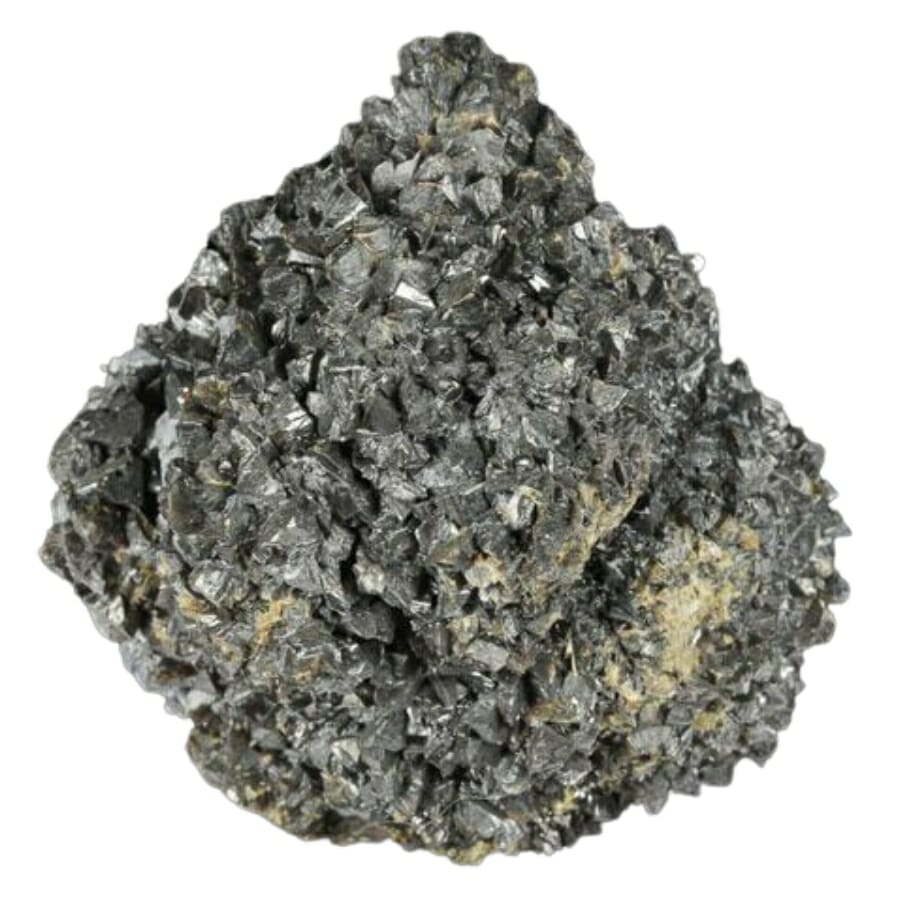
Sphalerite is the brightest mineral in the zinc group. It has a shiny look and a wide range of colors, from pale yellow to deep red and black. It knows how to be the center of attention. It’s like having a kaleidoscope of gems all in one!
This mesmerizing mineral is composed of zinc sulfide and is often found near other valuable ores. Both miners and collectors would want to get their hands on it.
Hot hydrothermal fluids flow through the Earth’s crust carrying minerals with them. As these fluids cool down, the zinc and sulfur they carry settle out, making its crystals. It’s often found with lead, copper, and silver ores, which makes it a good way to find other minerals.
Beyond its appearance, sphalerite has many uses in many different industries. Its main claim to fame is how much zinc it has. The zinc is taken from it and used to make many things, from batteries and galvanized steel to sunscreen and even nutritional supplements.
It’s also a favorite among mineral collectors and lapidaries because of its bright colors and beautiful crystal formations. Sphalerite is a highly valued mineral in geology and industry because it benefits the economy.
Where you can find Sphalerite in Texas
There are a lot of sphalerites in Texas, especially in the following places:
- Bonanza Mine
- Chinati Mountains
Tektite
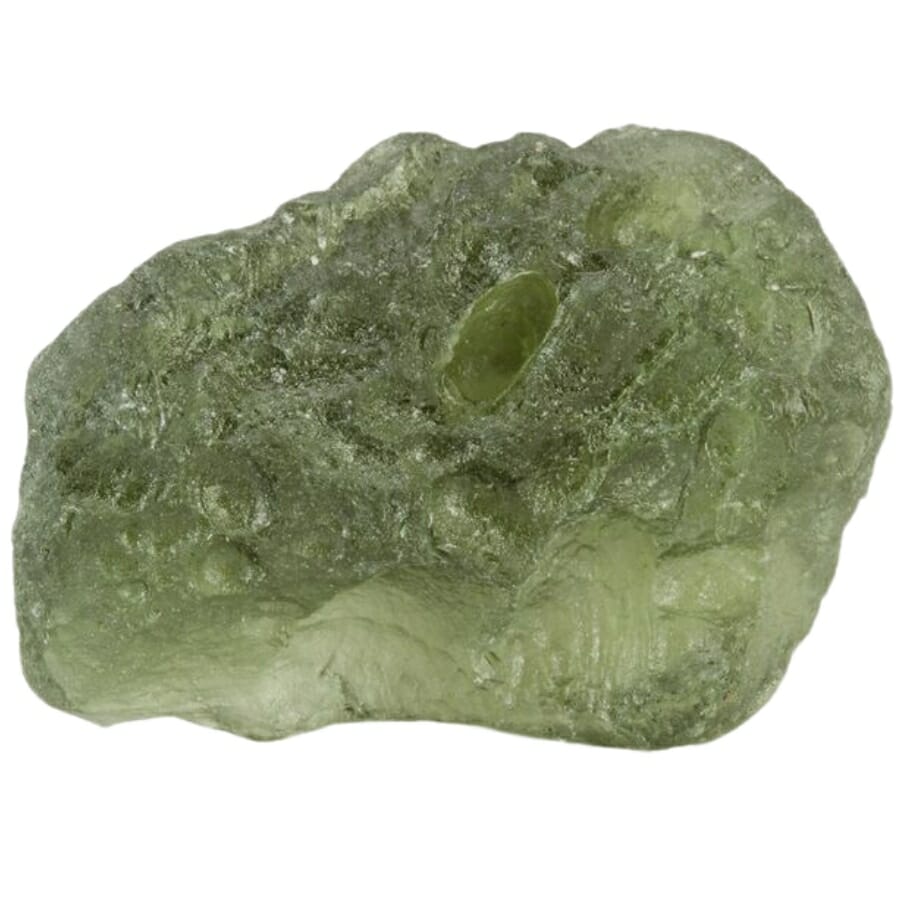
Tektite, the mysterious space traveler of the mineral world, is a fascinating gem that has piqued the interest of scientists and collectors alike. But here’s the real kicker: tektite isn’t even a mineral! It’s a type of glass made by impacts on Earth.
When a meteorite crashes into the Earth’s surface with a lot of force, it creates a lot of heat and pressure, which melts the rocks around it and causes a fiery explosion. As the molten material cools and solidifies, tektites are formed, each with its shape and texture.
These celestial gems come in different shapes, like tiny round beads, teardrop shapes, and even button-like disks. Their colors range from dark black and green to browns and grays resembling dirt.
Tektites usually have a smooth, glassy surface with lines made as the molten material cooled and moved during the impact. These lines are called “flow lines.”
Even though they aren’t used in everyday life like other minerals, they are essential to scientists and enthusiasts. Looking at them, you can learn a lot about past impacts and our planet’s geological history.
Also, collectors are very interested in these cosmic gems because of their unique history and connection to space. Tektites are still highly valued for their rarity and scientific importance and for how they seem to come from somewhere else.
Where you can find Tektite in Texas
You can find tektites in the following areas:
- Broad area around Bedias
- Gibbons creek
- Grimes countywide
- Nails Creek Park
The Gemstones Found In Texas
Let’s learn more about the gemstones that you can find in Texas. If you want a complete guide, we’ve put together a list of the detailed articles we’ve written:
Agate
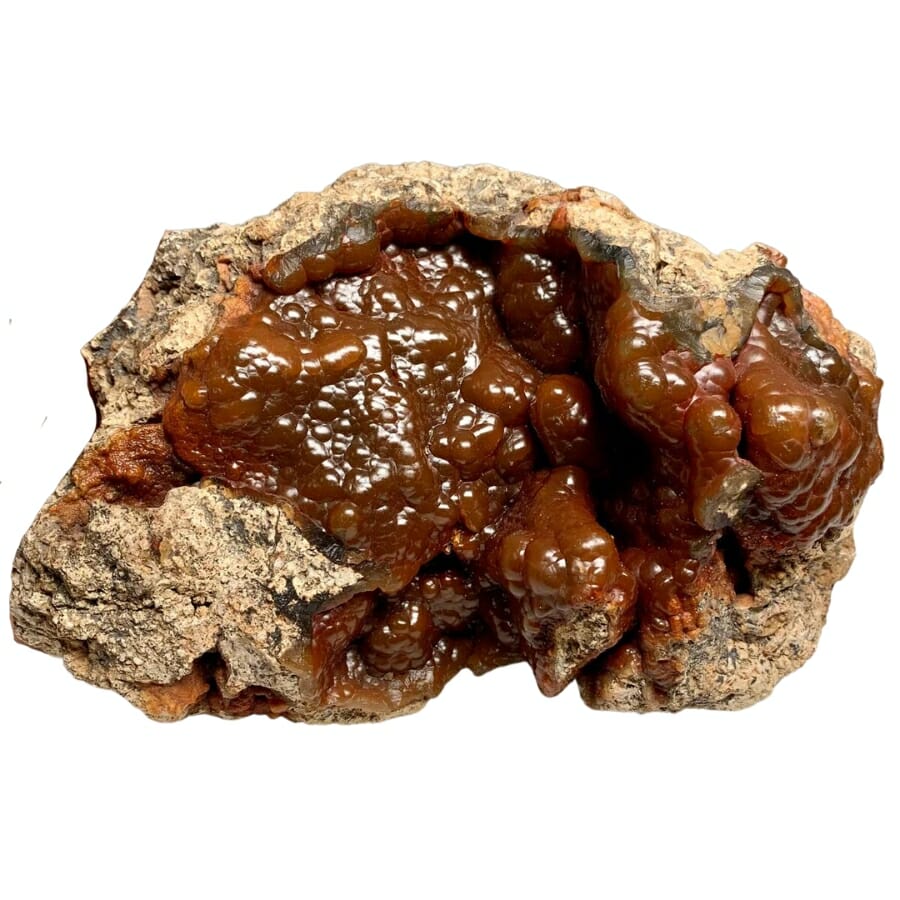
Agate is a big deal in the mineral world. It has such a wide range of colors and patterns that each piece is a real work of art. What makes agate so interesting is how it was made.
It starts to take shape when mineral-rich fluids fill the holes in volcanic rocks. As these liquids cool and solidify, they form beautiful bands and intricate patterns. The colors, ranging from earthy browns and reds to bright blues and greens, are pretty.
It has been prized for its many uses since ancient times. Agate has long been a favorite in the world of jewelry and decorations. It’s cut and polished to make gemstones that look great in rings, necklaces, and earrings.
Ancient civilizations valued it for its protective and healing properties, believing it could ward off negative energies and promote emotional balance. It’s still used in holistic practices, believed to enhance mental clarity and promote inner peace.
In addition to its beauty and spiritual value, agate is highly valued for being one of a kind. Each stone has its patterns and colors, so no two are alike. It’s a popular gem among collectors and people who like to wear jewelry.
Because of its geological history and natural beauty will continue to be a valued gemstone for many years.
Where you can find Agate in Texas
Here are the places where you can find agate in the state:
- Brewster county
- Needle Peak in the Study Butte area
- Quitman Mountains
- Terlingua Creek banks
Amber

Amber, known as the “ancient jewel of nature,” is a fascinating resin with secrets from the distant past. It looks like a time capsule from millions of years ago. It’s made from the resin of very old trees, like pines and other conifers.
When these trees suffered injuries or produced excess resin, it oozed out and hardened over time, trapping and preserving plant matter, insects, and even small animals.
The result is a beautiful gemstone whose colors range from golden yellow to deep orange and brown, giving it a warm and timeless beauty.
One of the reasons it’s so valuable is because of its historical and cultural significance. It’s been used for thousands of years as jewelry, amulets, and decorative pieces. In ancient times, it was believed to possess mystical powers, bringing luck and protection to its wearer.
It’s also been used in traditional medicine for its purported healing properties, believed to soothe ailments and promote well-being. Its unique ability to preserve prehistoric specimens makes it a valuable resource for scientists and researchers.
Amber is a piece of history that has been frozen in time. It’s still loved for its beauty, meaning, and fascinating ability to connect us to the ancient world.
Where you can find Amber in Texas
Amber can be found all over Texas, but especially in these areas:
- Eagle Pass
- Terlingua Creek banks
Carnelian
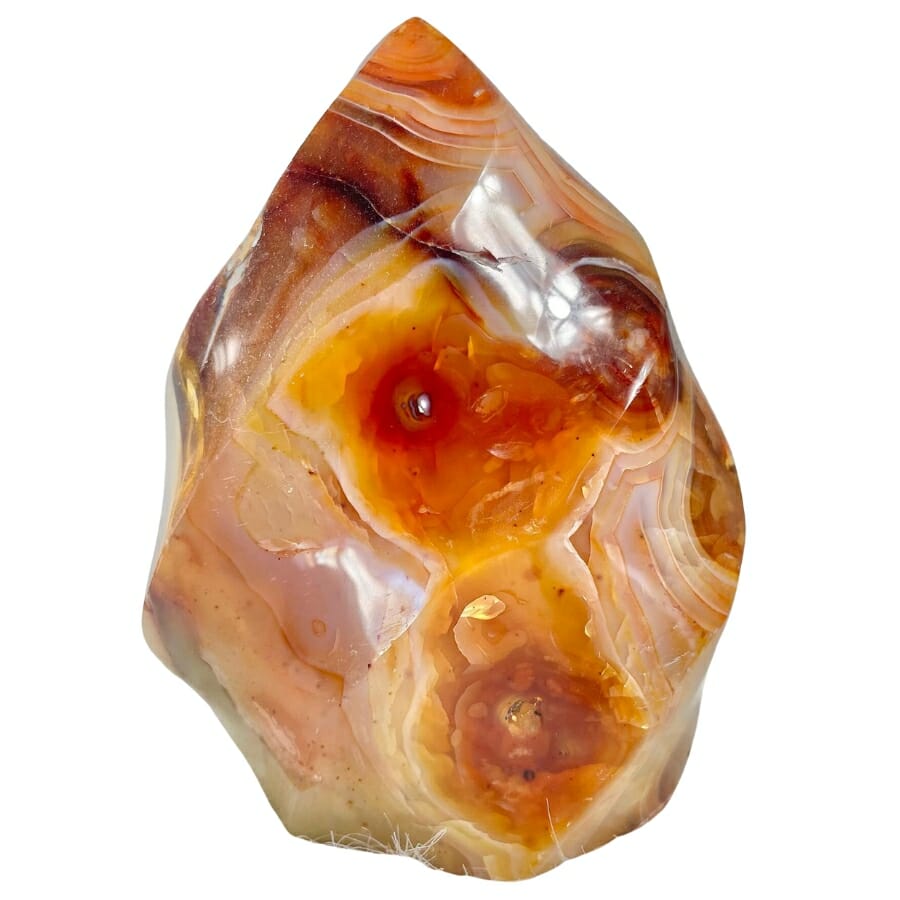
Carnelian is a fiery gem in the quartz family. It’s one of the most beautiful stones in the world. It’s like a sunset in a gem, with bright red, orange, and brown shades. Its bright colors come from iron oxide, which makes it stand out in any jewelry collection.
It was made when water with lots of silica moved through rocks and filled in holes over time. In ancient times, it was considered a stone of courage and protection, worn as an amulet to ward off evil spirits.
It was also associated with fertility and vitality, making it a famous stone for carvings and talismans. Today, carnelian remains a favored gemstone for jewelry, where it’s cut and polished into beads, cabochons, and pendants.
Its warm and rich hues make it an excellent choice for statement pieces and design to capture attention and admiration. Beyond its use in jewelry, it holds various metaphysical properties.
Carnelian is believed to boost creativity, energize the body, and promote feelings of positivity and motivation. In alternative healing practices, it’s often associated with the Sacral Chakra, helping to balance emotions and enhance self-expression.
Because of how it looks and what people think it can do for them, carnelian is a valued and cherished gemstone with aesthetic and spiritual appeal.
Identifying carnelian can be challenging, especially when it shares similarities with other rocks and minerals. Fortunately, our user-friendly guides are here to provide you with the tools to distinguish it easily:
Where you can find Carnelian in Texas
Carnelian can be located in the famous Quitman Mountains.
Chalcedony
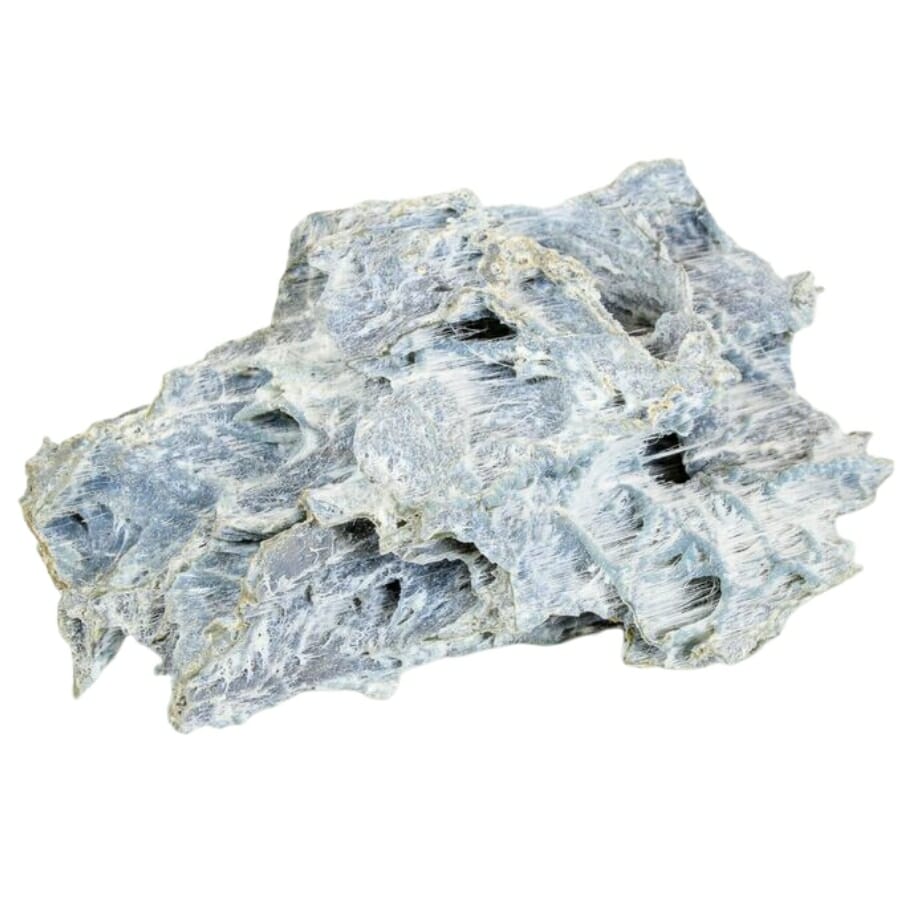
Chalcedony is like a whisper of nature’s beauty, with colors like soft blues, calming greens, creamy whites, and warm browns. It’s a favorite among jewelry designers, who craft it into exquisite cabochons, beads, and carved ornaments.
This gem is made when silica-rich water gets into cracks or holes in rocks and stays there. Over time, the water slowly evaporates, leaving behind tiny crystals. This gives it a smooth, see-through look.
Its gentle colors and soft sheen make it a versatile and complementary addition to various jewelry pieces. It also lends itself to intricate carvings and engravings, showcasing the artist’s skill and creativity.
In addition to its aesthetic appeal, chalcedony is used in various decorative and functional items, such as vases, bowls, and even knife handles, adding a touch of elegance to everyday objects.
It’s admired for its beauty, healing properties, and symbolism. It’s believed to promote feelings of calmness, improve communication, and foster emotional balance.
In ancient times, the gem was associated with various mystical and protective powers, used in talismans and amulets to safeguard against negative energies. With its timeless allure and versatile applications, chalcedony remains a cherished gemstone that stands the test of time.
You can read our article about how much chalcedony is worth if you want to know its current prices.
Where you can find Chalcedony in Texas
There are many deposits of chalcedony in Texas, especially in these places:
- Eagle Pass
- Glass Mountain
- Gravels of Hinton Creek
- River bars and tributaries of the Rio Grande River
- Stillwell Ranch
Quartz
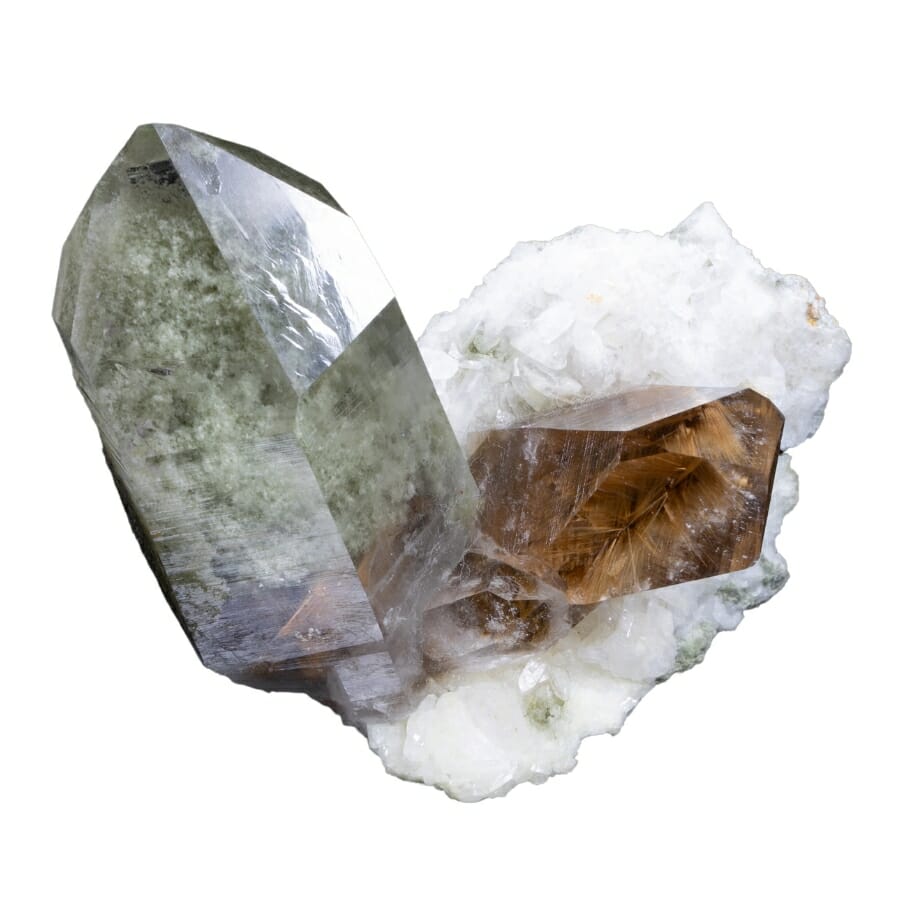
Quartz, the mighty workhorse of the mineral kingdom, is a mineral made of silicon and oxygen atoms, and it’s one of the most abundant minerals on Earth.
Its incredible variety is truly fascinating – it comes in all sorts of colors, from clear and icy white to vibrant hues like amethyst purple and citrine yellow. You name it, and quartz has got it!
This rockstar is formed deep within the Earth’s crust when super-hot magma cools down slowly, allowing the silicon and oxygen atoms to combine and crystallize into the mesmerizing gem we know and love.
The versatility of this gem has earned it a special place in our everyday lives. Its hardness and durability make it a popular choice for jewelry, where it’s crafted into faceted gemstones, beads, and cabochons.
In addition to its aesthetic appeal, it also plays a vital role in the technological world. It’s used in electronics, as its piezoelectric properties enable it to generate and respond to electric charges, making it an essential component in various devices, from watches to cell phones.
Quartz also has healing and spiritual significance, with practitioners using it for meditation and energy cleansing to enhance harmony and well-being.
Whether dazzling us in a jewelry store or powering our electronic gadgets, quartz remains an invaluable and cherished mineral, leaving a sparkling trail throughout history and the modern world.
Our comprehensive guides are here to assist you in distinguishing quartz from other rocks and minerals so confusion won’t get the best of you:
Where you can find Quartz in Texas
Quartz is abundant in Texas, but you can particularly find them here:
- Glass Mountain
- Pala Duro Canyon State Park
- Plata Verde Mine
- Stillwell Ranch
- West to Enchanted Rock in Llano county
Topaz
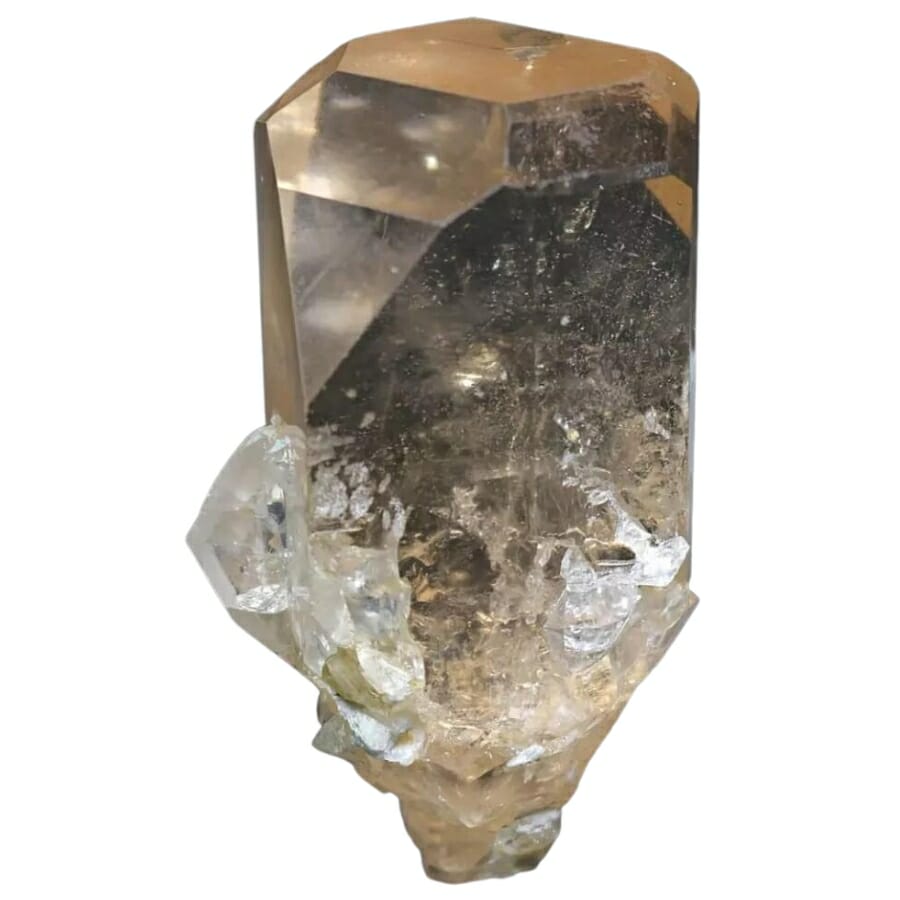
Topaz is a silicate mineral made of aluminum, silicon, and oxygen. Known for its stunning ray of colors, it dazzles in shades of blue, yellow, orange, and even rare hues like pink and red.
This gem is formed through hydrothermal processes, where hot water rich in minerals percolates through rocks and dissolves various elements. As the water cools and moves through fractures in the Earth’s crust, it deposits the minerals into cavities and fractures, where they crystallize and form beautiful gems.
The diverse uses of topaz contribute to its immense value and popularity. As a gemstone, it’s adored by jewelry designers, who cut it into various shapes like faceted gems or cabochons, creating exquisite pieces for rings, necklaces, and earrings.
Its brilliance and various colors make it a favorite among gem enthusiasts and collectors. It also plays a role in the technological world, which is used in electronics and optical equipment.
Its unique properties, such as its high refractive index and piezoelectric characteristics, make it valuable for creating precision components in various devices, including cameras and sensors.
This gem has a long history, and people think it has magical and healing powers. In the past, it was believed to be a sign of strength and protection, and people wore it as a charm to keep bad things away.
It has also been linked to good qualities like wisdom, bravery, and loyalty. Topaz is still valued for its beauty, meaning, and versatility, and it has left a bright path in the world of minerals and gemstones.
Where you can find Topaz in Texas
There are several places you can visit to find topaz in Texas, including:
- Bar M Ranch
- Baringer Hill Mine
- Countywide pegmatite exposures
- Lindsay Ranch
- Pegmatite outcrops of the Gritt area
Turquoise
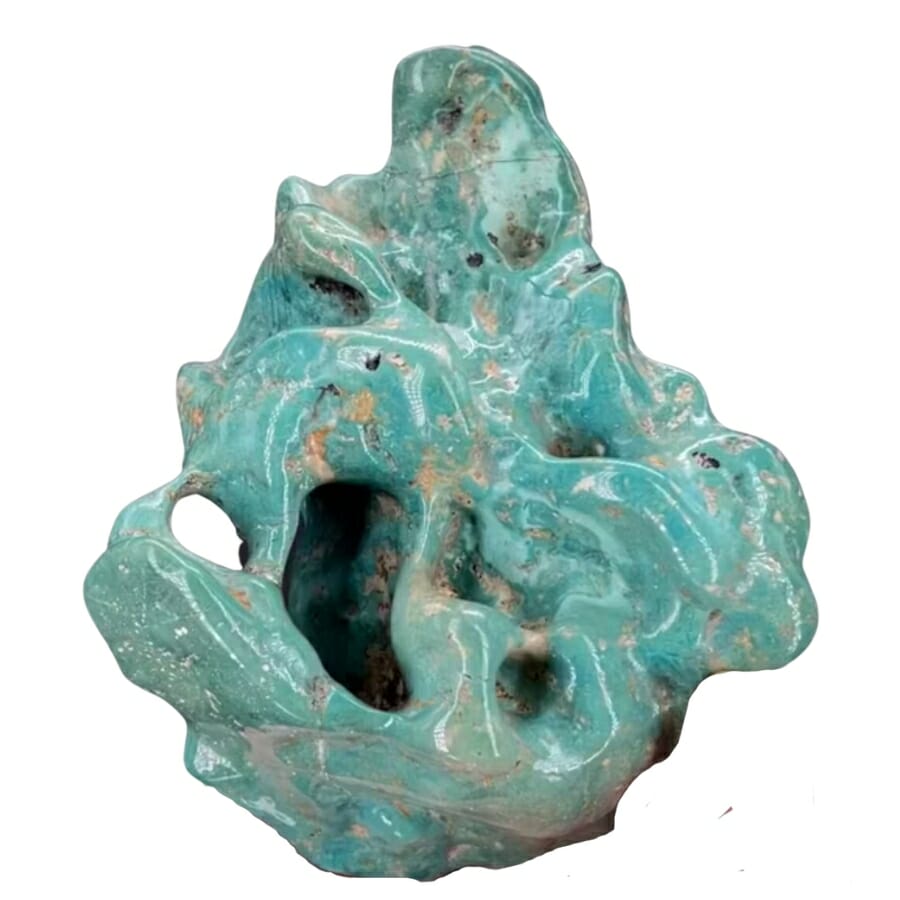
Turquoise is a hydrated phosphate of copper and aluminum. It’s a popular gem with a history as colorful as its bright color. People have prized it worldwide for thousands of years because of its beautiful blue-green color.
This valuable gem forms in dry areas where water seeps through copper-rich rock formations and picks up minerals. As the water evaporates, it leaves behind deposits, which slowly harden into the beautiful gems we know and love.
Turquoise has a special place in ancient and modern cultures because of how it looks and what it means to people. It’s used often in necklaces, bracelets, and rings because it has beautiful colors and can be cut into cabochons, beads, and inlays.
Because the gem is thought to bring protection and luck, it has been used in amulets and talismans for a long time. Many Native American tribes consider it a sacred stone because they believe it can bring peace and help people get better.
It has been used in different cultures to decorate statues, ornaments, and ceremony items. Because of its popularity in arts and crafts, its also used to make pottery, mosaics, and even paint pigments.
Even now, turquoise is still valued for its beauty and cultural significance, making it a treasured gem that has left a lasting mark on the world of minerals and art.
Where you can find Turquoise in Texas
Turquoise is easy to find in Texas, especially in the following places:
- Maltby Mine
- Prospects at the northeast side of the Carrizozo Mountains
- Sierra Blanca area mines
To help you tell turquoise apart from other very similar-looking rocks and minerals, check out our guides below:
The Crystals Found In Texas
In Texas, you can find a lot of mesmerizing crystals that are very valuable to collectors and crystal enthusiasts. You can learn more about these crystals below.
We’ve also created a more detailed article on where to find crystals in Texas:
Amazonite
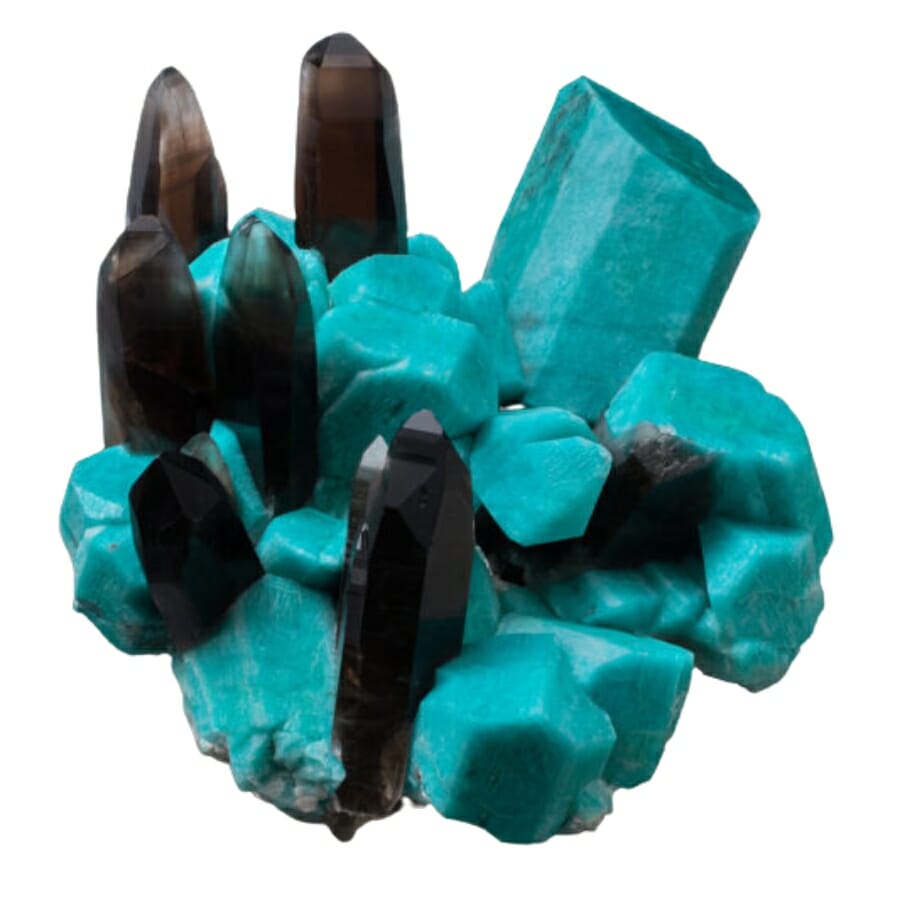
Amazonite is a beautiful crytsal in the Feldspar family, which looks like a cool turquoise-blue breeze. This mineral gets its name from the Amazon River, even though it’s not found there.
It’s a type of microcline feldspar known for its unique blue and green colors and often white streaks or mottled patterns. It’s made when potassium-rich solutions mix with other minerals in igneous rocks as they cool.
Amazonite is believed to promote peace, balance, and harmony and to help people communicate better and develop new ideas. It’s often used for meditation and emotional healing by healers and people who work with energy.
This crystal is also popular for jewelry design because of its unique and soothing colors. It’s cut into cabochons, beads, and pendants. The crystal’s versatility lets it go well with different metals and other crystals, making it a favorite of jewelry designers and fans.
Amazonite is more than just a pretty stone to wear on your body. It has also been used to make decorations and works of art. Ancient people liked how it looked and used it to make amulets, beads, and statues.
Even now, it is used to make sculptures, mosaics, and inlays. The crystal’s historical importance and its current use in jewelry and art have helped it keep its value and respected status in the worlds of minerals and design.
Where you can find Amazonite in Texas
These places are usually where you can find amazonite in the state:
- Ranches in Mason county
- Streeter area
Amazonite is often mistaken for similar rocks and minerals, so here are some guides to help you tell it apart:
Celestite
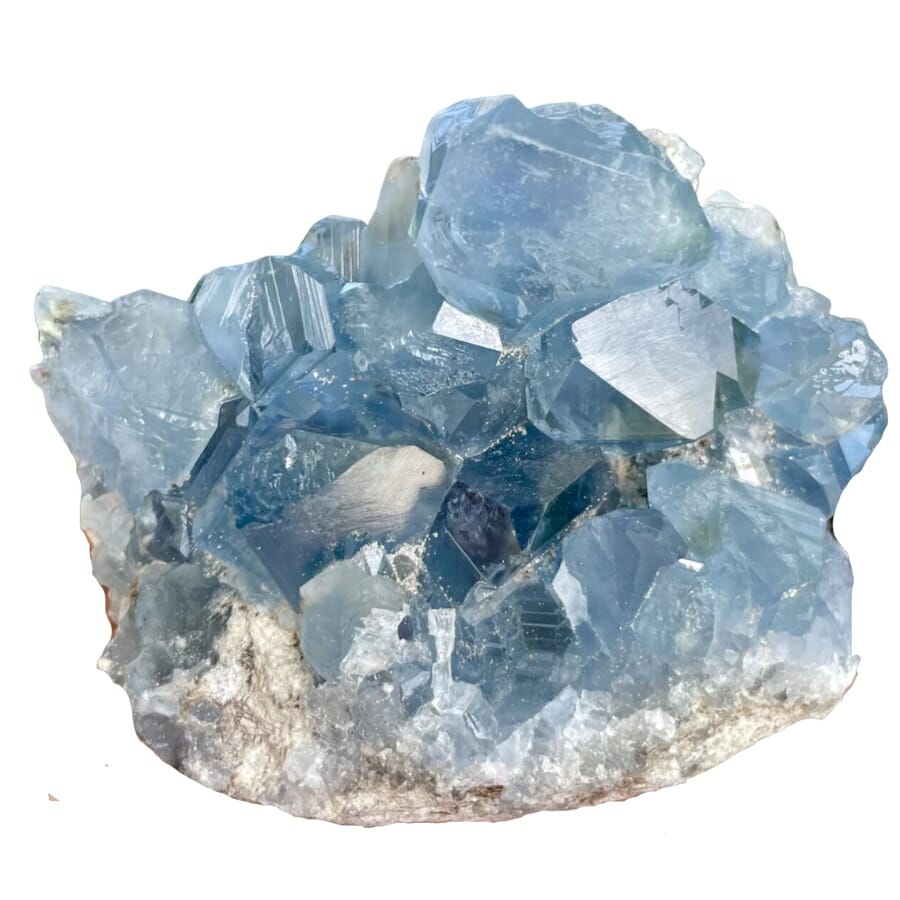
Celestite is known as the “heavenly beauty” of minerals because of its soft shades of blue, giving it an ethereal look and feel. It’s made of a mineral called strontium sulfate. It’s usually found in sedimentary rock, where it forms in geodes or crystal cavities.
It’s made by hydrothermal processes, in which hot water full of minerals seeps through rocks and leaves behind strontium sulfate in the form of beautiful crystals.
Celestite is also highly valued for its ability to clear energy, which makes it a popular choice for spiritual and energy healing work. It’s often used in meditation and spiritual practices to help people connect with higher realms and feel more at peace with themselves.
It’s also a sign of clear communication and self-expression because it is linked to the throat chakra.
It’s used to make strontium compounds because it contains strontium. These compounds are used in many industries, such as pyrotechnics, ceramics, and glass-making.
But celestite’s main value comes from its beauty and the fact that it is linked to peace and spirituality. It shines brightly in the hearts of those who admire its celestial beauty and use it as a tool for inner growth and balance.
Where you can find Celestite in Texas
In Texas, celestite can be found here:
- Buffalo Creek
- Little Lucy Creek
- Numerous mine deposits at Zephyr in Brown county
- Palo Duro Canyon State Park
- Sweetwater open pit mine in Nolan county
Fluorite
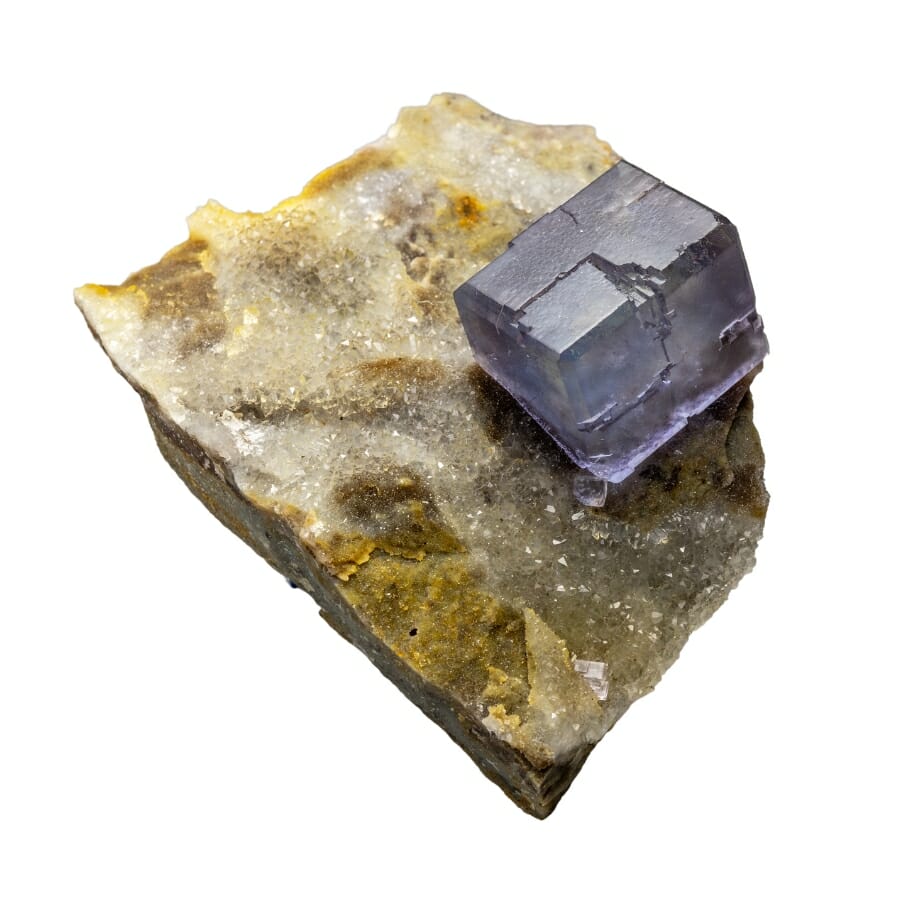
Fluorite is a calcium fluoride gemstone known for its many different colors. It’s often called the “kaleidoscope” of minerals. Its wide range of colors, from beautiful purples and blues to bright greens and yellows, is like a light show made by nature.
This beautiful stone is made in hydrothermal veins, where hot water full of minerals flows through rocks. As the water cools and hardens, it deposits calcium fluoride, which forms the beautiful crystals we love to look at.
One reason it’s so valuable is because of how it looks. It fluoresces when exposed to ultraviolet light, giving it a beautiful glow that adds to its mystery. It’s called “the fluorescent gem” because of this property.
Fluorite is also used in optics and lenses because it can let light through. This makes it useful in several scientific and industrial fields. Collectors also like it because of its complex crystal structures and color zoning, which make each piece a unique treasure.
It’s used in metaphysical healing and spiritual practices, showing its versatility, and believed to protect the person who wears it from negative energies and make them more spiritually aware.
People say its calming energies help people think more clearly and feel more stable. Talismans have used it for centuries in many different cultures.
Its aesthetic appeal and the belief in its metaphysical properties make fluorite a cherished gemstone, leaving a colorful and lasting impression on collectors and spiritual seekers.
Where you can find Fluorite in Texas
You can find unique pieces of fluorite in the following places:
- Baringer Hill area mines
- Chinati Mountain
- Kingsland area mines
Galena
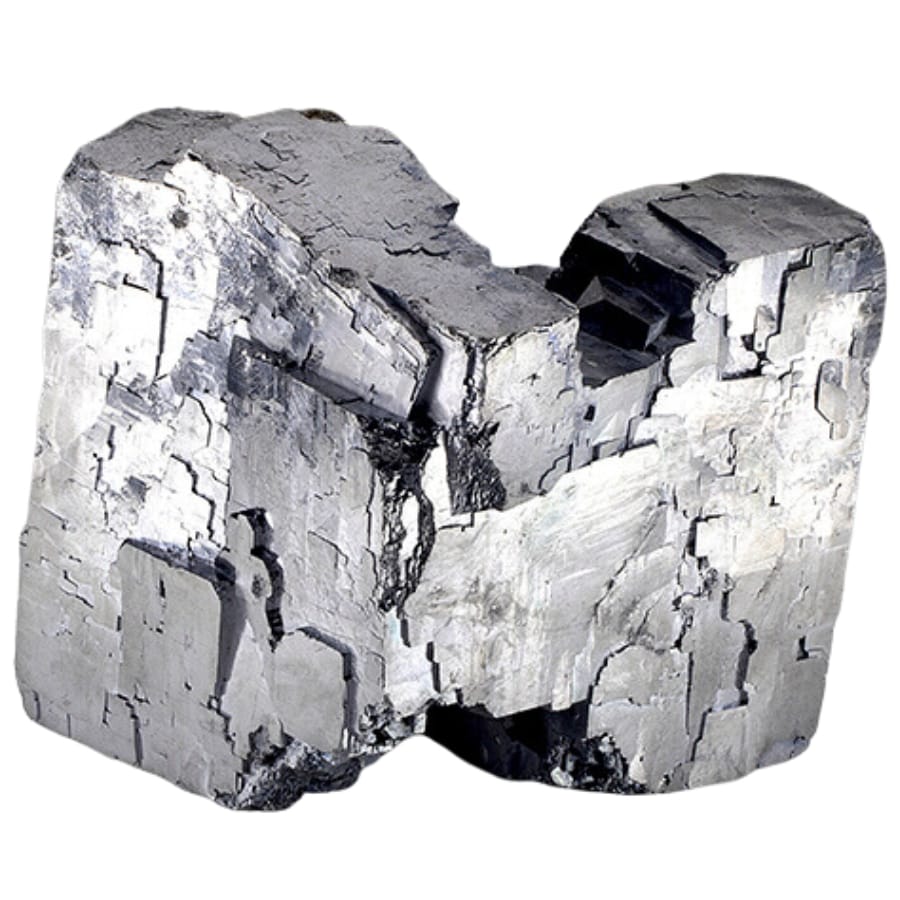
Galena, a lead sulfide mineral with a lot of charm, has been a big deal in the mining world for a long time. It stands out among minerals like a rock star because of its unique silvery-gray color and metallic shine.
It’s usually found with other valuable minerals like silver, zinc, and copper in hydrothermal veins and sedimentary rocks. This crystal is an important ore of lead. It forms when lead-rich hydrothermal fluids cool and deposit the mineral in cracks and fissures, making the famous cube-shaped crystals.
Galena is essential to the economy and is the primary source of lead. This gives it value. Lead is an important metal for many things, like making batteries, soldering, and blocking radiation.
In the past, lead was often used in water pipes and as a part of paints. However, health concerns have made people use lead less in these ways. Lead is still an essential part of many industrial processes and products.
Aside from its use in industry, galena has been used as a decorative stone for a long time. It has been made into jewelry in different cultures and used as an inlay. Mineral collectors and lapidaries also like it because it looks striking and metallic.
Where you can find Galena in Texas
Galena is located in the following areas:
- Altuda area mines
- Sierra Diablo and other mines
- Silver Creek
- Solitario area mines
Muscovite
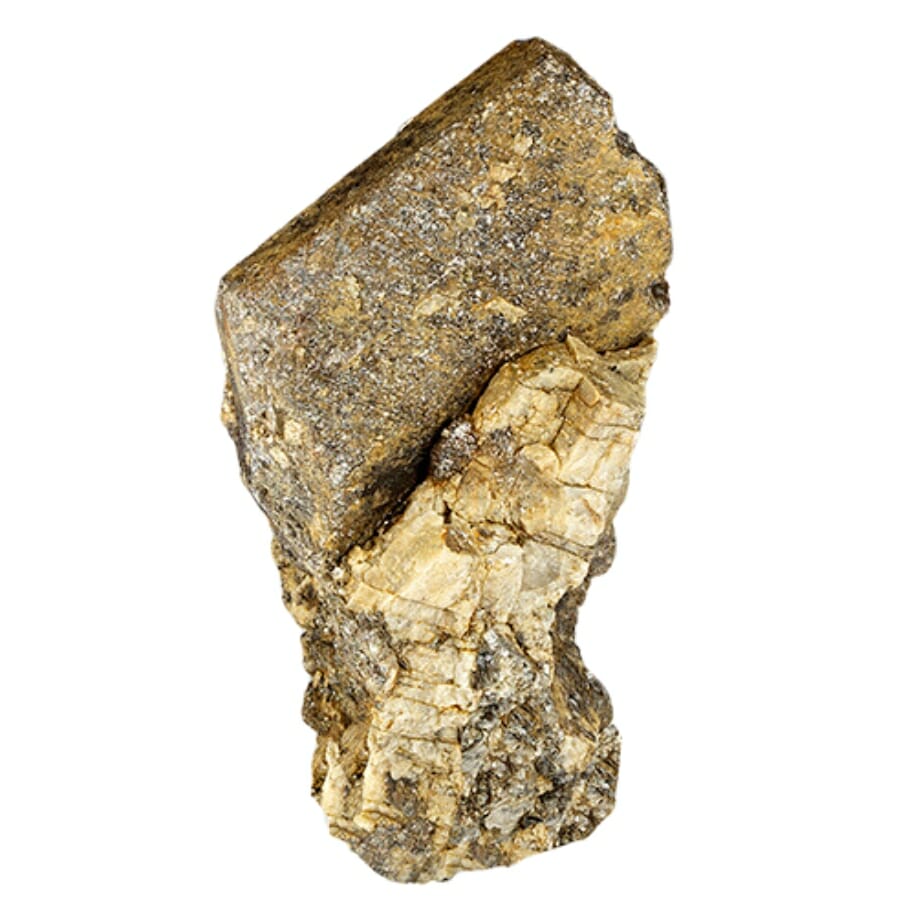
Muscovite is a mineral that sparkles and is a member of the mica family. It’s known for its silvery shine and clearness. The name of this beautiful gem comes from the area of Russia where it was first found, “Muscovy.”
It’s a mineral made up of potassium, aluminum, and silicon. It is a sheet silicate. It forms in metamorphic rocks, usually when minerals like feldspar and granite that were already there are changed by high pressure.
Its unique properties, such as its excellent electrical and thermal insulating abilities, make it an essential component in electrical equipment and insulation products. Its versatility and contributions to technology and daily life make muscovite an invaluable mineral in modern society.
Muscovite is also a staple in the world of cosmetics and personal care products, where it’s used in shimmery makeup and skincare items. Furthermore, it manufactures specialized glass, paints, and coatings.
In addition to its industrial importance, it’s admired for its ornamental and spiritual qualities. Muscovite sheets have been used as windowpanes in ancient times, providing a glimpse into historical architecture.
Crystal enthusiasts appreciate its calming and balancing properties, believing it aids in releasing emotional blockages and promoting positive energy. As a mineral of many facets, muscovite continues to be valued for its practical uses and mystical allure, shining as a true gem in the world of minerals.
Where you can find Muscovite in Texas
Muscovite is abundant at the Plata Verde Mine.
Smithsonite
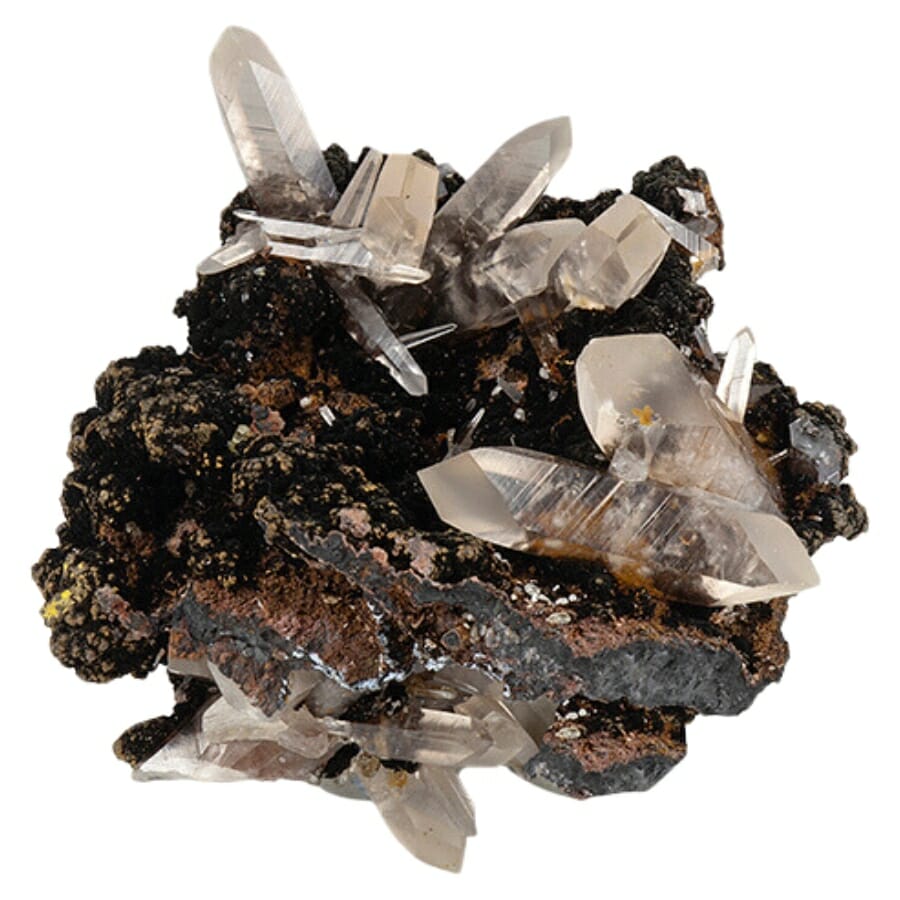
Smithsonite is a beautiful and colorful carbonate mineral that is also a gemstone. Its wide range of colors is what makes it so attractive. It’s a mineral that forms in the oxidation zone of zinc ore deposits.
It is also called zinc spar or zinc carbonate. As water moves through these deposits, it reacts with the zinc minerals and carries the zinc ions. When the water reaches the surface and comes into contact with air, it evaporates.
This causes the zinc ions to form smithsonite, which is a rock. The result is a beautiful gem with shades of blue, green, pink, purple, yellow, and brown.
The value of smithsonite lies in its varied uses and appeal to collectors and jewelry enthusiasts. This gem is highly regarded among mineral collectors for its eye-catching colors and unique crystal formations.
In jewelry, it’s a beloved choice for creating exquisite and distinctive pieces. It’s often cut into cabochons, beads, and pendants, showcasing its vibrant hues and adding a touch of elegance to necklaces, bracelets, and earrings.
Additionally, smithsonite is used to create decorative items, including vases, boxes, and sculptures, where its diverse color palette allows for artistic expression.
Aside from its ornamental uses, it’s also a significant zinc ore. Zinc is essential in various industrial applications, from galvanizing steel to manufacturing batteries and alloys.
Mining smithsonite contributes to the global zinc supply and supports various industries. The mineral’s aesthetic appeal and economic significance make smithsonite a valuable and cherished gemstone.
Where you can find Smithsonite in Texas
You can look at the Chinati Mountains for unique pieces of smithsonite.
The Most Valuable Rocks and Minerals in Texas
Now that we’ve discussed Texas’s different rocks, minerals, and gems, let’s discuss the most valuable ones you can find here. You might locate both of them if you’re lucky.
Blue Topaz
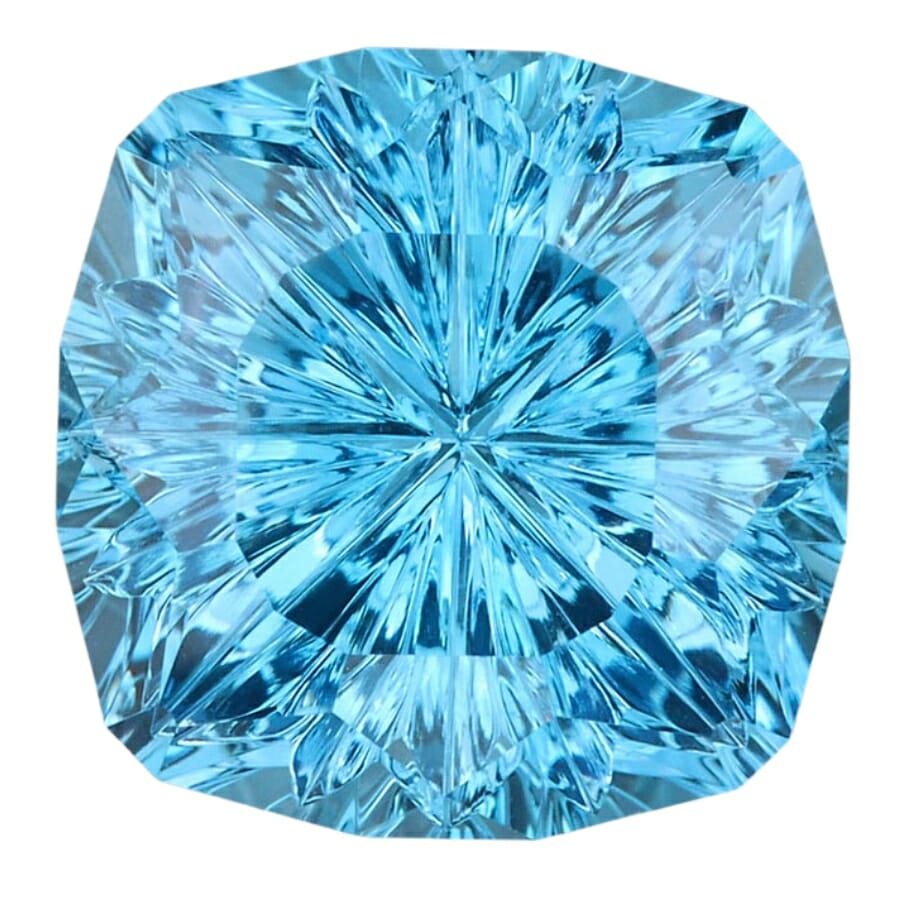
Blue topaz is the official state gem of Texas. It’s a bright gem in the same family as topaz and its beautiful blue color makes it stand out. This stone’s beautiful blue color comes from a process in which colorless or pale topaz is irradiated and heated to change its color.
The treatment makes the gem shine more, so jewelry designers and people who like gems love to use it. It can range from a light sky blue to a deep Swiss blue or London blue. This gives jewelry lovers looking for a bright and affordable gem many options.
It’s valuable because it is cheap and looks like more expensive blue gemstones like aquamarine and sapphire. Blue topaz is a good choice for people who want a gem with beautiful color and sparkle that won’t break the bank.
Its strength and durability make it a good material for everyday jewelry, such as rings, necklaces, earrings, and bracelets. It’s often used with other gemstones and metals to add a pop of color and a sophisticated touch to designs with more than one stone.
Beyond its ornamental uses, blue topaz is also associated with various metaphysical and healing properties. It’s believed to promote calmness, balance, and clear communication. Some practitioners use blue topaz for meditation and spiritual practices to enhance inner peace and self-expression.
Whether admired for its visual appeal, spiritual attributes, or economic accessibility, blue topaz continues to shine brightly as a cherished gemstone in the minerals and jewelry design world.
Where you can find Blue Topaz in Texas
You can dig for blue topaz in the following ranches in Texas:
- Bar M Ranch
- Lindsay Ranch
- Seaquist Ranch
As mentioned above, blue topaz is often mistaken for similar rocks and minerals. So to help you tell it apart from other, here are some guides you can use:
Petrified Palm Wood
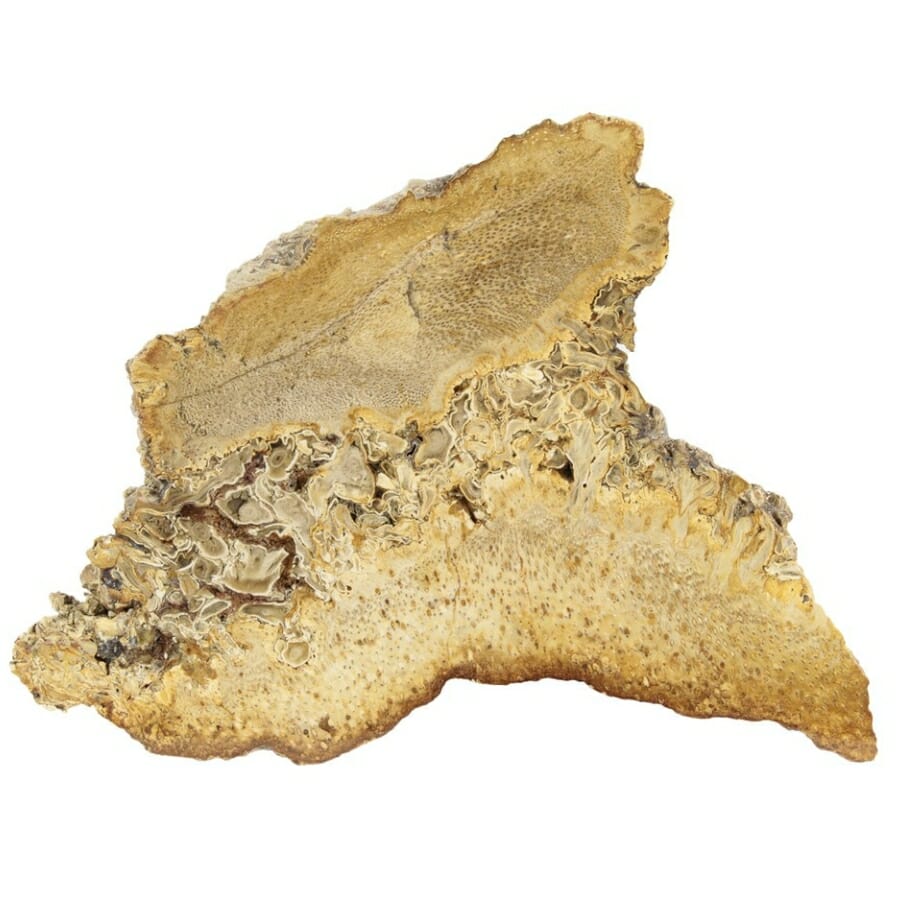
Petrified palm wood, the fascinating fossil of Earth’s history, is not your typical gemstone. It’s a unique form of fossilized wood resulting from permineralization. Over millions of years, fallen palm trees from ancient forests became submerged in sediment and buried deep within the Earth.
During this burial process, minerals from groundwater gradually replaced the organic matter in the wood, transforming it into stone. The result is a beautiful mosaic of colorful patterns and intricate details, retaining the original structure of the wood.
The charm of petrified palm wood lies in its aesthetic appeal and role as a living relic of the past. The rich colors and unique patterns, formed by combining different minerals, make each piece a masterpiece.
It’s often used in lapidary work, where it’s cut and polished into cabochons, beads, and decorative objects. It’s a favored material for jewelry designers and collectors alike, with each piece telling a story of ancient forests and the passage of time.
Beyond its use in adornments, petrified palm wood also has practical applications. The stone’s durability and hardness make it suitable for various decorative items, from tabletops and countertops to bookends and sculptures.
Its unique appearance and historical significance have also made it a popular choice for collectors and enthusiasts of Earth’s natural wonders. As a tangible link to our planet’s past, petrified palm wood continues to be treasured and valued for its beauty and its role in preserving the history of our world.
Where you can find Petrified Palm Wood in Texas
You can also check out the detailed article we’ve written about where you can find petrified wood in Texas once you’ve visited the following areas where it’s abundant:
- Area creek beds and banks of New Caney
- Erdman Farm
- Lake Livingston
- Large area between Camden and Chester
How to Identify The Rocks and Minerals You Find
You don’t have to know much about rocks and minerals or have complicated tools to identify them. If you want to identify a sample on your own, you can do the following simple tests:
Evaluate its color
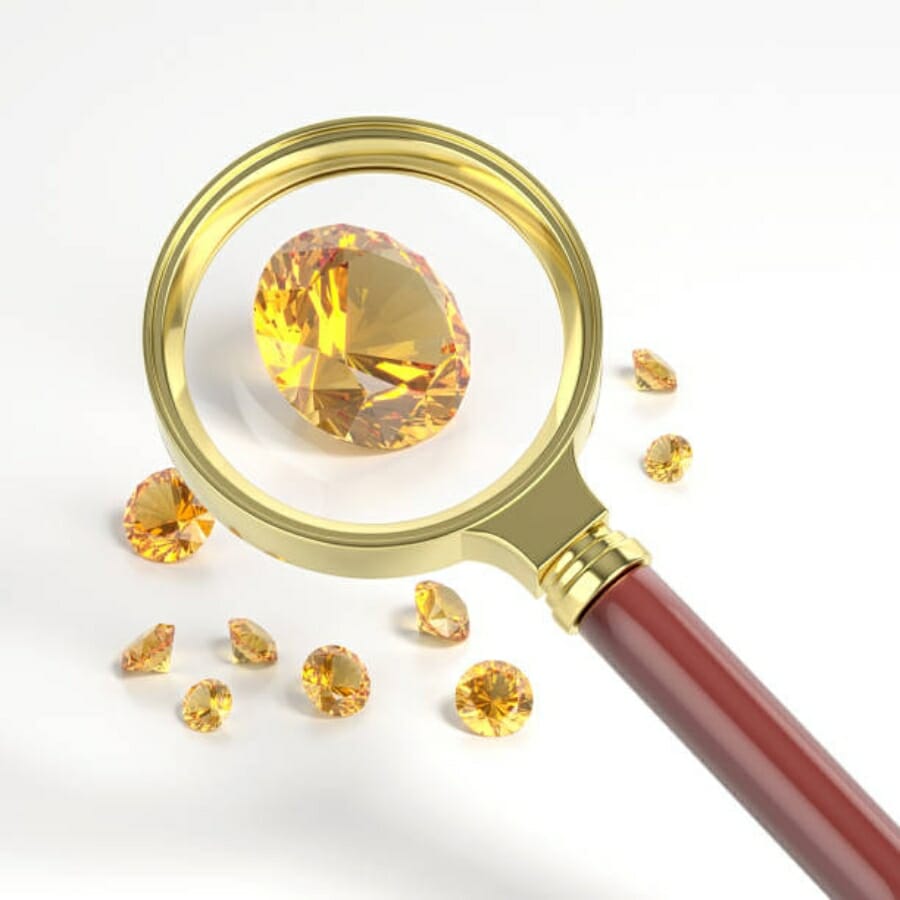
The most obvious thing about a specimen is its color. But it can sometimes mislead you because it comes in many colors. Other factors can also change the color of the specimen.
Looking at the color of your mineral is a good place to start. Careful observation of its physical features can provide valuable information when identifying rocks.
Conduct a streak test
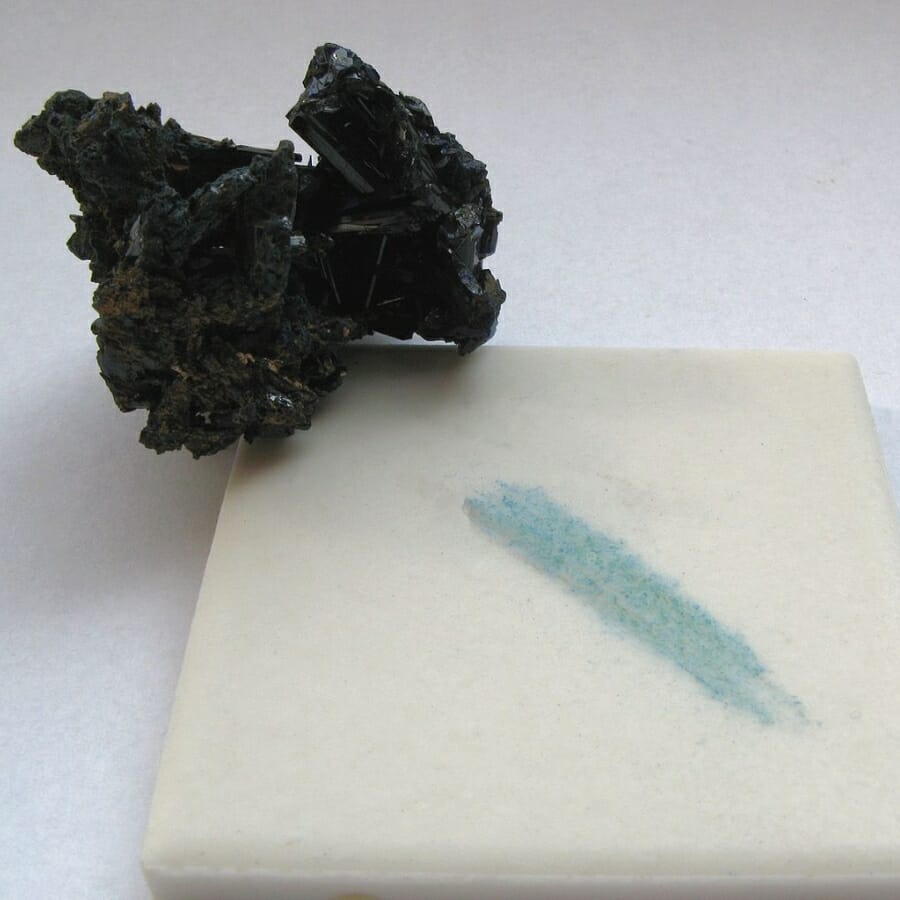
Do a streak test to find out what color a mineral’s powder is. Rub the mineral against a plate of unglazed porcelain or white tile. The color of the mark left behind can be used to determine what kind of mineral it is.
It’s important to remember that the streak test works best for figuring out which minerals are softer than the streak plate. Harder minerals might not leave a streak or scratch the plate instead.
For harder minerals, you may need to use other ways to figure out what they are, like the Mohs hardness test or the specific gravity test.
Mohs hardness test
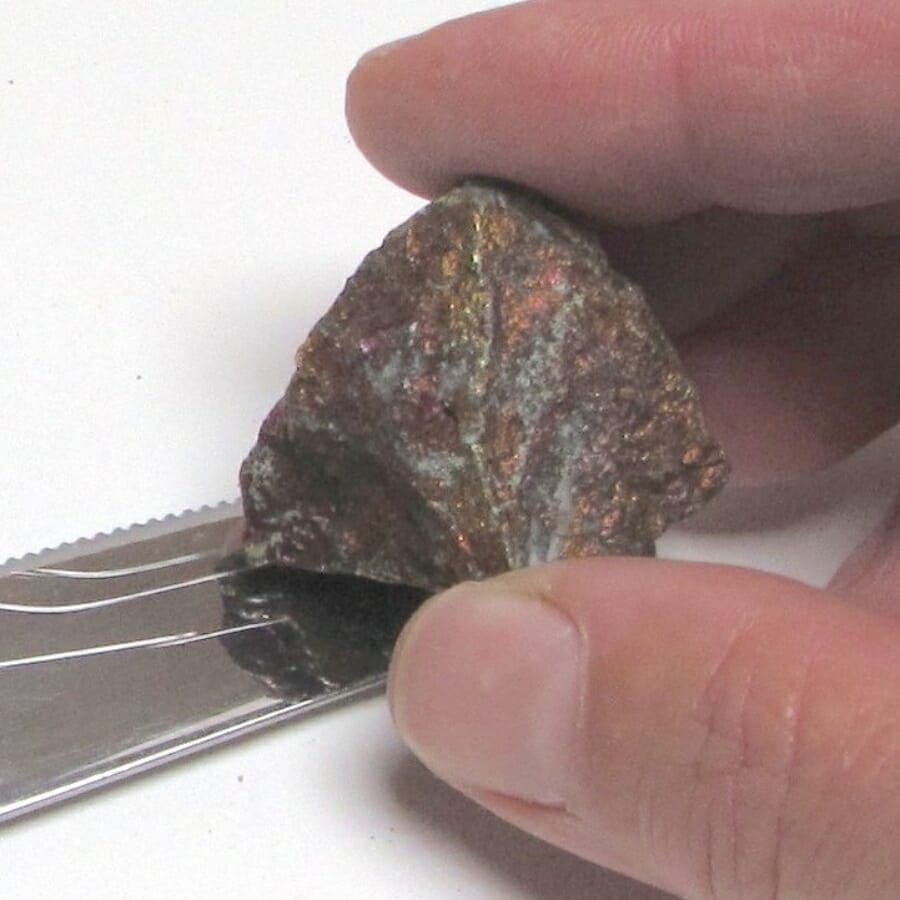
The Mohs scale is a system that ranks minerals based on their relative hardness, from 1 (softest) to 10 (hardest). For example, talc is the softest mineral with a hardness of 1, while diamond is the hardest mineral, with a hardness of 10.
You will need a set of minerals with known hardness values to perform the test. Mohs hardness test kits usually include 10 minerals ranging from talc (1) to diamond (10). If you don’t have a test kit, you can also use common objects like a fingernail (2.5), a copper penny (3.5), a steel nail (5.5), and a glass plate (5.5).
If the test mineral leaves a scratch on the specimen, its hardness is greater than the hardness of the test mineral. If there is no scratch, try the next hardest mineral in your kit until you find the one that does scratch the specimen.
Use a field guide or mineral chart
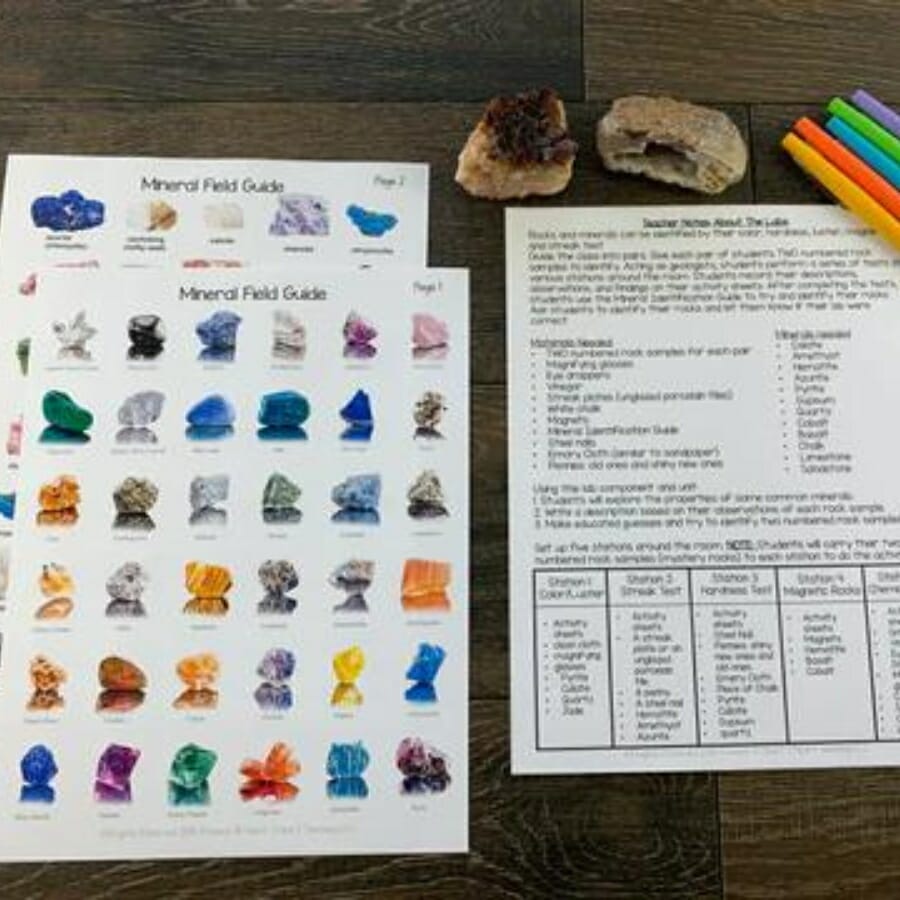
Carry a field guide or use a mineral identification chart to compare the properties of the specimen with known minerals. The guide will provide information on common minerals and their characteristics.
Remember that figuring out what a mineral is can be hard sometimes, especially if it has similar properties to other minerals. You will be better able to use mineral charts for identification if you learn about different minerals and what makes them unique through practice and experience.

